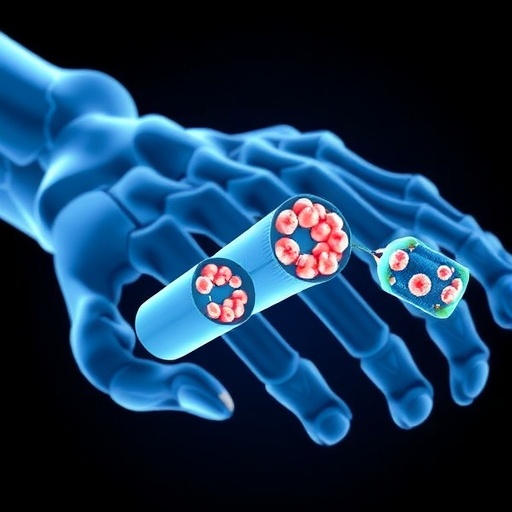A groundbreaking development in the realm of biomedical engineering is poised to revolutionize the way we approach bone regeneration. A team of researchers from Penn State University has successfully engineered an innovative implantable biodegradable scaffold known as CitraBoneQMg. This new scaffold combines the biocompatibility of magnesium and glutamine with citric acid, creating an environment conducive to accelerated bone growth. Published in the esteemed journal Science Advances, the research signifies a substantial leap forward in medical science, particularly in the realm of orthopedic surgery.
The traditional method for treating broken bones often involves immobilizing the injury with a cast or brace while allowing bone cells to regenerate autonomously. However, when faced with severe fractures or complex breaks, standard healing methods may not suffice, necessitating surgical intervention. Surgeons typically utilize grafts or scaffolds made from biocompatible materials, or they employ metal fixation devices to ensure proper alignment and healing of the fracture. The Penn State team’s innovative approach, however, introduces a new paradigm in scaffold design, potentially transforming the landscape of orthopedic treatments.
At the heart of CitraBoneQMg’s effectiveness is the synergistic relationship between its key components: magnesium, glutamine, and citric acid. First author Hui Xu, a doctoral student in biomedical engineering, elucidates how these molecules work in concert to enhance bone regeneration. By promoting increased intracellular energy metabolism, the scaffold effectively encourages bone cell proliferation and activity. This mechanism represents a significant advancement compared to traditional citric acid-only implants, previously approved by the U.S. Food and Drug Administration and widely available on the market.
Through meticulous research, the team discovered that by incorporating magnesium and glutamine into the citric acid scaffold, they could positively influence two energy pathways crucial for bone growth: AMPK and mTORC1. These pathways are pivotal in regulating cellular energy balance, ensuring that cells have the requisite energy to synthesize new bone tissue. This novel approach of using the three molecules in tandem marks a substantial departure from conventional scaffolding methods, which typically rely on a singular focus on one pathway or another.
In Xu’s words, the CitraBoneQMg scaffold acts like a power boost for bone cells. Unlike traditional methods where one pathway accelerates while the other decelerates, the scaffold promotes balanced regulation of both pathways. This synergistic relationship essentially enhances the scaffolding’s ability to provide stem cells with the energy they need to differentiate into bone-forming cells. This leads to more robust bone regeneration and offers hope for patients recovering from significant fractures.
To validate the effectiveness of CitraBoneQMg, the researchers employed a comprehensive experimental methodology. They implanted the innovative scaffold into cranial defects in rats and closely monitored the resultant bone growth against those treated with a conventional citric acid-only scaffold and an established traditional bone material implant. Remarkably, the findings indicated a staggering 56% increase in bone growth surrounding cranial injuries in the CitraBoneQMg group compared to those with the citric acid scaffold, and an astonishing 185% increase when compared to the traditional bone material group.
The implications of these findings extend beyond mere bone regeneration. Alongside rapid bone growth, the researchers observed vital nerve regeneration and anti-inflammatory properties at the scaffold site, which are crucial elements for the long-term healing of the bone. The integrated approach of releasing these essential metabolites directly at the injury site is a transformative strategy, providing high concentrations of nutrients precisely where they are most needed, as opposed to relying on oral administration that yields minimal efficacy at the injury site.
Furthermore, the scaffold’s unique properties extend into the realm of imaging technology. The inherent photoluminescent and photoacoustic characteristics of the polymer scaffold facilitate easy imaging post-implantation, allowing clinicians to track the scaffold’s effectiveness in real-time. With the scaffold’s photoacoustic properties, it is highly promising for in vivo tracking as it can be detected by ultrasound deep within bodily tissues, providing a groundbreaking tool for monitoring recovery.
The collaborative efforts of the Penn State team include various notable figures in the field of biomedical engineering, ushering in a new phase of research within this critical area. Alongside Xu and Yan, the contributing authors—doctoral students Ethan Gerhard, Rohitraj Ray, and Yuqi Wang, as well as seasoned faculty such as Sri-Rajasekhar Kothapalli and April D. Armstrong—highlight the collaborative nature of this research. This interdisciplinary effort emphasizes the importance of pooling knowledge and resources to tackle complex medical challenges effectively.
As the research community eagerly awaits further exploration of the CitraBoneQMg’s potential applications, it serves as a reminder of the ever-evolving landscape of medical science. The groundwork laid by this team not only paves the way for enhanced orthopedic treatments but may also open doors to further innovations in tissue engineering and regenerative medicine. As clinical applications of this technology take shape, the anticipated benefits could extend to countless individuals facing the challenges of severe fractures or complex bone injuries.
In conclusion, the development of CitraBoneQMg represents a significant milestone in the pursuit of advanced, effective bone regeneration techniques. As the medical field builds upon these promising findings, the hope is that new treatments will emerge—offering patients faster recovery times, improved healing, and ultimately, a higher quality of life. The interplay of innovative biomaterials and cellular biology showcased in this research underscores the exciting possibilities that lie ahead in the intersection of technology and health care.
Subject of Research: Animals
Article Title: Metabotissugenic citrate biomaterials orchestrate bone regeneration via citrate-mediated signaling pathways
News Publication Date: 23-Jul-2025
Web References: Science Advances
References: 10.1126/sciadv.ady2862
Image Credits: Caleb Craig/Penn State
Keywords
Tissue growth




